TO
Filters: Collection: "ir_eua"
| Title | Date | Subject | Description | ||
|---|---|---|---|---|---|
| 1 |
 |
Solar Parking Project | 2011 | Solar Energy; Parking; University of Utah | Feasibility study to install photo voltaic structures at the University of Utah. |
| 2 |
 |
2011 University of Utah General Catalog | 2011 | University of Utah catalogue; (Catalog) | This item is made available by the J. Willard Marriott Library, using a Web archiving service. Items that are only available as Web sites are being crawled using Archive-it.org, and can be accessed by selecting "Access this item" above. The current faculty listing for the catalogue; can be found at ... |
| 3 |
 |
2011 Group Ticket Pricing (UUSAC) | 2011 | Group ticket pricing for the Rio Tinto stadium in 2011 | |
| 4 |
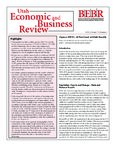 |
Census 2010 - a first look at Utah results | 2011 | Census; 2010; Utah; Demographics; Population; Age; Sex; Race; Ethnicity | Early results from the long-awaited 2010 Census are revealing the outlines of the more detailed portrait that will not be available for at least a couple more years. This essay reviews the top-level population change and geographic distribution results primarily from the redistricting data set.1 We ... |
| 5 |
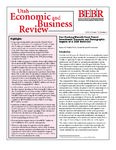 |
Fast-tracking Wasatch Front transit investments: economic and demographic impacts of a 2025 build-out | 2011 | Over the next 30 years, the Wasatch Front will significantly expand its transit network. Plans include the construction of an additional 25 miles of light rail, 76 miles of commuter rail, 227 miles of bus rapid transit, and 29 miles of mountain transportation rail line. These projects will be built ... | |
| 6 |
 |
Accelerating deployment of retrofitable CO2 capture technologies through predictivity: (Simulation, verification, validation / uncertainty quantification) - 2010 Annual report (for year 1 of 3) to DOE NNSA from The University of Utah | 2011 | CO2; CO2 capture technologies; predictivity; fossil-fuel utilization | There is an ever increasing national awareness that an effective, sustainable energy future must include fossil-fuel utilization that deploys cost-efficient technologies (both new and retrofit) that significantly improve energy efficiencies and reduce CO2 emissions over existing electric power and t... |
| 7 |
 |
Land and resource management issues relevant to deploying in-situ thermal technologies: Topical Report: October 1, 2009 to December 31, 2010 | 2011-01 | in-situ; oil shale; domestic energy source; oil sands | Utah is home to oil shale resources containing roughly 1.3 trillion barrels of oil equivalent and our nation's richest oil sands resources. If economically feasible and environmentally responsible means of tapping these resources can be developed, these resources could provide a safe and stable dome... |
| 8 |
 |
Clean and secure energy from domestic oil shale and oil sands resources: Quarterly progress report: October 2010 to December 2010 | 2011-01 | ICSE; Oil shale; Oil sands; University of Utah; Marriott Library; Macroscale CO2 analysis; CO2 capture; Flameless oxy-gas process heaters; Liquid fuel production; In-situ thermal processing | The Clean and Secure Energy from Domestic Oil Shale and Oil Sands Resources program is part of the research agenda of the Institute for Clean and Secure Energy (ICSE) at the University of Utah. In this quarter, the Clean and Secure Energy program circulated External Advisory Board recommendations an... |
| 9 |
 |
Policy analysis of produced water issues associated with in-situ thermal technologies: Topical report: October 1, 2009 to December 31, 2010 | 2011-01 | topical report; produced water issues; in situ thermal technologies; oil shale/sands; water rights; domestic energy source | Commercial scale oil shale and oil sands development will require water, the amount of which will depend on the technologies adopted and the scale of development that occurs. Water in oil shale and oil sands country is already in scarce supply, and because of the arid nature of the region and limita... |
| 10 |
 |
Phase 2: Clean and secure energy from coal: Quarterly progress report: October 1, 2010 to December 31, 2010 | 2011-01-31 | domestic coal resources; CO2 capture; stationary power generation; LES; DQMOM approach; oxy-coal flames; coal | The University of Utah is pursuing research to utilize the vast energy stored in our domestic coal resources and to do so in a manner that will capture CO2 from combustion from stationary power generation. The research is organized around the theme of validation and uncertainty quantification throug... |
| 11 |
 |
State and Regional Control of Geological Carbon Sequestration Topical Report - Reporting Period July 1, 2008 to September 30 2010 | 2011-03 | control of geological carbon sequestration; IOGCC; Interstate Oil and Gas Compact Commission; CO2 emissions | The United States has economically recoverable coal reserves of about 261 billion tons, which is in excess of a 250‐year supply based on 2009 consumption rates. However, in the near future the use of coal may be legally restricted because of concerns over the effects of its combustion on atmospher... |
| 12 |
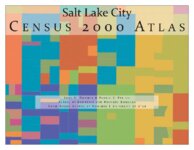 |
Salt Lake City census 2000 atlas | 2011-03 | Demographics; Salt Lake City; Utah; Census | This volume presents the basic demographic characteristics of residents of Salt Lake City as recorded in the 2000 Census of Population and Housing. Every ten years these federal governm ent counts of people are the basis of congressional apportionment and political redistricting. Data in this volume... |
| 13 |
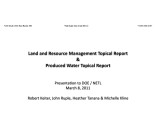 |
Land and resource management topical report and produced water topical report | 2011-03-08 | water topical report; land management; resource management; oil sands; oil shale | |
| 14 |
 |
Subtask 6.1: Engineering process models for economic impact analysis | 2011-03-10 | engineering process models; economic impact analysis; domestic heavy oil; developing domestic heavy oil/sands/shale resources | A presentation given at the Unconventional Fuels from Oil Shale and Oil Sands Project Review Meeting on March 10-11, 2011. In the project objectives, the purpose of assessment is to "Examine limiting factors to the development of domestic heavy oil, oil sands, and oil shale resources. Identify poli... |
| 15 |
 |
Subtask 4.3: Multiscale thermal processing of oil shale | 2011-03-10 | thermal processing; oil shale; oil shale treatment; thermal treatment | |
| 16 |
 |
Subtask 4.4: Effect of oil shale processing on water composition | 2011-03-10 | oil shale processing; water composition; unconventional fuels; oil shale; oil sands; oil shale development | A presentation at the Unconventional Fuels from Oil Shale and Oil Sands Project Review Meeting on March 10-11, 2011. The overall goal is to asses aquifers in the Uinta Basin to determine where saline water (produced along with conventional petroleum development) can be disposed without harming fresh... |
| 17 |
 |
Subtask 4.5: Pore scale analysis of oil shale/sands pyrolysis | 2011-03-10 | pore scale analysis; oil shale pyrolysis; oil sands pyrolysis; x-ray CT; pore network structure; flow simulation; LB method | A presentation given at the Unconventional Fuels from Oil Shale and Oil Sands Project Review Meeting on March 10-11, 2011. |
| 18 |
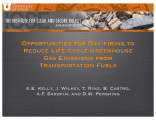 |
Opportunities for oxy-firing to reduce life-cycle greenhouse gas emissions from transportation fuels | 2011-03-10 | GHG; oxy-firing; reduce greenhouse gas emissions; transportation fuel emissions; CO2 analysis; oil sands | The outline covers in this presentation covers: GHGs and the transportation fuel cycle. Motivation for reducing GHG emissions. Use of oxy-firing for CO2 capture in refining of conventional fuel. Use of oxy-firing for extraction and upgrading of oil sands. GHG emissions from other scenarios Would oxy... |
| 19 |
 |
Subtask 4.6: Kerogen/asphaltene/mineral matrix: Structure and interactions | 2011-03-10 | DOE review meeting; mineral matrix; recover organic material from oil shale/sands | A presentation given at the Unconventional Fuels from Oil Shale and Oil Sands Project Review Meeting on March 10-11, 2011. |
| 20 |
 |
A market assessment of heavy oil, oil sands, and oil shale resources | 2011-03-10 | unconventional fuels; market assessment; developing domestic heavy oil, oil sands, and oil shale resources; preliminary infrastructure needs | A presentation given at the Unconventional Fuels from Oil Shale and Oil Sands Project Review Meeting on March 10-11, 2011. |
| 21 |
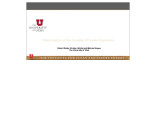 |
Policy analysis of the Canadian oil sands experience | 2011-03-10 | policy analysis; Canadian oil sands experience; oil sands; federal oil sands resources; oil sands development; unconventional fuels | The presentation goes over analyzing the relevance of the Canadian experience to U. S. oil sands development. This report focuses on federal oil sands resources, specifically potential development in the STSA's. No Current development on federal lands, despite leasing authorization under the Combine... |
| 22 |
 |
Subtask 3.2: Flameless oxy-gas process heaters for efficient CO2 capture | 2011-03-11 | Oxy-gas process heaters; efficient CO2 capture; oxy-gas combustion | This is a presentation given at the Unconventional Fuels from Oil Shale and Oil Sands Project Review Meeting in March 10-11, 2011. |
| 23 |
 |
DOE project review: Subtask 4.2 (B): Examination of in situ production models | 2011-03-11 | DOE project review; in situ production models; oil shale; unconventional fuels; oil sands; geomechanics; general reservoir simulation tool | A presentation given at the Unconventional Fuels from Oil Shale and Oil Sands Project Review Meeting on March 10-11, 2011. The objectives of the presentation is the examination of in-situ production methods, different in-situ production method options, rigorous energy and carbon balances, exploratio... |
| 24 |
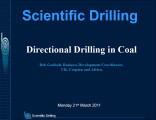 |
Scientific drilling: Directional drilling in coal | 2011-03-21 | scientific drilling; directional drilling in coal; drilling; UCG training course; UCG | UCG Training Course, March 21-22, 2011, Deloitte, London |
| 25 |
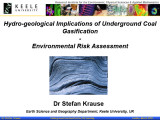 |
Hydro-geological implications of Underground Coal Gasification: Environmental risk assessment | 2011-03-21 | hydro-geological implications; underground coal gasification; UCG; environmental risk assessment; hydrological processes; hydrochemical processes | UCG Training Course, March 21-22, 2011, Deloitte, London |
